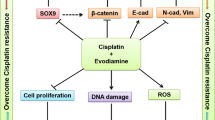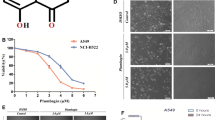Abstract
Purpose
Tongue squamous cell carcinoma (TSCC) is the most common highly invasive oral cancer. Glaucocalyxin A (GLA) is a diterpenoid component isolated from Rabdosia japonica var. with anti-bacterial and anti-cancer biological properties. However, the role of GLA in human TSCC remains uncertain. The aim of this paper was to investigate the anti-cancer effect of GLA on TSCC cells as well as its underlying mechanism.
Methods
Cell viability and growth were analyzed by CCK-8 assay and colony formation, respectively. DAPI staining and flow cytometry assay were used to detect the cell apoptosis. Lysotracker Red staining was used to observe the lysosomes and autolysosomes of TSCC cells. ROS fluorescent probe was used to test the intracellular ROS levels. Western blotting was used to detect the expression levels of apoptosis- and autophagy-related proteins.
Results
GLA inhibits the cell viability and growth in TSCC cells. GLA induces TSCC cells apoptosis, autophagy and ROS production in a time- and concentration-dependent manner. In addition, GLA inhibits the viability of TSCC cells by inducing intracellular ROS production. Finally, GLA triggers ROS-dependent apoptosis and autophagy in TSCC cells.
Conclusion
Our results consistently suggested that GLA can induce apoptosis and autophagy in TSCC cells by generating ROS. GLA may serve as a promising therapeutic drug for overcoming TSCC.





Similar content being viewed by others
Availability of data and material
Data will be made available on reasonable request.
References
Bilano V, Gilmour S, Moffiet T, d’Espaignet ET, Stevens GA, Commar A, Tuyl F, Hudson I, Shibuya K (2015) Global trends and projections for tobacco use, 1990–2025: an analysis of smoking indicators from the WHO comprehensive information systems for tobacco control. Lancet 385:966–976
Jamal A, Phillips E, Gentzke AS, Homa DM, Babb SD, King BA, Neff LJ (2016) Current cigarette smoking among adults—United States. Morb Mortal Wkly Rep 67(2018):53–59
Tota JE, Anderson WF, Coffey C, Califano J, Cozen W, Ferris RL, St John M, Cohen EE, Chaturvedi AK (2017) Rising incidence of oral tongue cancer among white men and women in the United States, 1973-2012. Oral Oncol 67:146–152
Ng JH, Iyer NG, Tan MH, Edgren G (2017) Changing epidemiology of oral squamous cell carcinoma of the tongue: a global study. Head Neck 39:297–304
Fan T, Pi H, Li M, Ren Z, He Z, Zhu F, Tian L, Tu M, Xie J, Liu M, Li Y, Tan M, Li G, Qing W, Reiter RJ, Yu Z, Wu H, Zhou Z (2018) Inhibiting MT2-TFE3-dependent autophagy enhances melatonin-induced apoptosis in tongue squamous cell carcinoma. J Pineal Res 64:e12457
Dong Z, Gao Q, Guo H (2018) Glaucocalyxin A attenuates the activation of hepatic stellate cells through the TGF-β1/smad signaling pathway. DNA Cell Biol 37:227–232
Gao LW, Zhang J, Yang WH, Wang B, Wang JW (2011) Glaucocalyxin A induces apoptosis in human leukemia HL-60 cells through mitochondria-mediated death pathway. Toxicol In Vitro 25:51–63
Mao M, Zhang T, Wang Z, Wang H, Xu J, Yin F, Wang G, Sun M, Wang Z, Hua Y, Cai Z (1865) Glaucocalyxin A-induced oxidative stress inhibits the activation of STAT3 signaling pathway and suppresses osteosarcoma progression in vitro and in vivo. Biochim Biophys Acta Mol Basis Dis 2019:1214–1225
Zhu J, Sun Y, Lu Y, Jiang X, Ma B, Yu L, Zhang J, Dong X, Zhang Q (2018) Glaucocalyxin A exerts anticancer effect on osteosarcoma by inhibiting GLI1 nuclear translocation via regulating PI3K/Akt pathway. Cell Death Dis 9:708
Yang J, Liu Y, Xue C, Yu W, Zhang J, Qiao C (2014) Synthesis and biological evaluation of glaucocalyxin A derivatives as potential anticancer agents. Eur J Med Chem 86:235–241
Liu HC, Qiao LM, Zheng W, Xiang ZB, Chen HS, Yu SC, Zhang DZ, Wang T, Zhang YF, Jin YS (2020) Synthesis and cytotoxicity assessment of novel 7-O- and 14-O-derivatives of glaucocalyxin A. Anticancer Agents Med Chem 20:1241–1249
Sabharwal SS, Schumacker PT (2014) Mitochondrial ROS in cancer: initiators, amplifiers or an Achilles’ heel? Nat Rev Cancer 14:709–721
Prasad S, Gupta SC, Tyagi AK (2017) Reactive oxygen species (ROS) and cancer: role of antioxidative nutraceuticals. Cancer Lett 387:95–105
Gaikwad S, Srivastava SK (2021) Role of phytochemicals in perturbation of redox homeostasis in cancer. Antioxidants (Basel) 10:83
Xue D, Pan ST, Zhou X, Ye F, Zhou Q, Shi F, He F, Yu H, Qiu J (2020) Plumbagin enhances the anticancer efficacy of cisplatin by increasing intracellular ROS in human tongue squamous cell carcinoma. Oxid Med Cell Longev 2020:5649174
Li F, Song L, Yang X, Huang Z, Mou X, Syed A, Bahkali AH, Zheng L (2020) Anticancer and genotoxicity effect of (Clausena lansium (Lour.) skeels) peel ZnONPs on neuroblastoma (SH-SY5Y) cells through the modulation of autophagy mechanism. J Photochem Photobiol B 203:111748
Kirkin V, Rogov VV (2019) A diversity of selective autophagy receptors determines the specificity of the autophagy pathway. Mol Cell 76:268–285
Wang F, Gómez-Sintes R, Boya P (2018) Lysosomal membrane permeabilization and cell death. Traffic 19:918–931
Vega-Rubín-de-Celis S, Kinch L, Peña-Llopis S (2020) Regulation of beclin 1-mediated autophagy by oncogenic tyrosine kinases. Int J Mol Sci 21:9210
Xiang Z, Wu X, Liu X, Jin Y (2014) Glaucocalyxin A: a review. Nat Prod Res 28:2221–2236
Zhou X, Ma W, Li X, Xu J (2020) Glaucocalyxin a prevents hypoxia-induced epithelial-mesenchymal transition in human gastric cancer cells through the PI3K/Akt signaling pathway. J Recept Signal Transduct Res. https://doi.org/10.1080/10799893.2020.1853160
Jiang X, Zhang Z, Song C, Deng H, Yang R, Zhou L, Sun Y, Zhang Q (2019) Glaucocalyxin A reverses EMT and TGF-β1-induced EMT by inhibiting TGF-β1/Smad2/3 signaling pathway in osteosarcoma. Chem Biol Interact 307:158–166
Radha G, Raghavan SC (1868) BCL2: a promising cancer therapeutic target. Biochim Biophys Acta Rev Cancer 2017:309–314
Kopeina GS, Prokhorova EA, Lavrik IN, Zhivotovsky B (2018) Alterations in the nucleocytoplasmic transport in apoptosis: Caspases lead the way. Cell Prolif 51:e12467
Lin W, Xie J, Xu N, Huang L, Xu A, Li H, Li C, Gao Y, Watanabe M, Liu C, Huang P (2018) Glaucocalyxin A induces G2/M cell cycle arrest and apoptosis through the PI3K/Akt pathway in human bladder cancer cells. Int J Biol Sci 14:418–426
Liu Y, Lu S, Zhao L, Dong X, Zhu Z, Jin Y, Chen H, Lu F, Hong Z, Chai Y (2018) Effects of glaucocalyxin A on human liver cancer cells as revealed by GC/MS- and LC/MS-based metabolic profiling. Anal Bioanal Chem 410:3325–3335
White E, Mehnert JM, Chan CS (2015) Autophagy, metabolism, and cancer. Clin Cancer Res 21:5037–5046
Manent J, Banerjee S, de Matos Simoes R, Zoranovic T, Mitsiades C, Penninger JM, Simpson KJ, Humbert PO, Richardson HE (2017) Autophagy suppresses Ras-driven epithelial tumourigenesis by limiting the accumulation of reactive oxygen species. Oncogene 36:5576–5592
Wang Y, Xiong H, Liu D, Hill C, Ertay A, Li J, Zou Y, Miller P, White E, Downward J, Goldin RD, Yuan X, Lu X (2019) Autophagy inhibition specifically promotes epithelial-mesenchymal transition and invasion in RAS-mutated cancer cells. Autophagy 15:886–899
White E, DiPaola RS (2009) The double-edged sword of autophagy modulation in cancer. Clin Cancer Res 15:5308–5316
Zhou T, Zhuang J, Wang Z, Zhou Y, Li W, Wang Z, Zhu Z (2019) Glaucocalyxin A as a natural product increases amyloid β clearance and decreases tau phosphorylation involving the mammalian target of rapamycin signaling pathway. NeuroReport 30:310–316
Harris IS, DeNicola GM (2020) The Complex Interplay between Antioxidants and ROS in Cancer. Trends Cell Biol 30:440–451
Salehi F, Jamali T, Kavoosi G, Ardestani SK, Vahdati SN (2020) Stabilization of Zataria essential oil with pectin-based nanoemulsion for enhanced cytotoxicity in monolayer and spheroid drug-resistant breast cancer cell cultures and deciphering its binding mode with gDNA. Int J Biol Macromol 164:3645–3655
Peng Z, Zhang R, Pan L, Pei H, Niu Z, Wang H, Lv J, Dang X (2020) Glaucocalyxin A protects H9c2 cells against hypoxia/reoxygenation-induced injury through the activation of Akt/Nrf2/HO-1 pathway. Cell Transpl 29:963689720967672
Acknowledgements
The authors are in deep gratitude toward the science and technology department of Jiangxi Province. We would like to acknowledge the reviewers for their helpful comments on this paper.
Funding
This research was supported by the key researching project of Science and Technology Department of Jiangxi Province No. 2018ACG70009.
Author information
Authors and Affiliations
Contributions
JQ, FS, and DX designed the study. FS and DX performed every experiments, analyzed the data, and wrote the manuscript. QJ helped experimental verification. All authors read and approved the final manuscript.
Corresponding author
Ethics declarations
Conflict of interest
All authors declared no conflicts of financial interests to this study.
Additional information
Publisher's Note
Springer Nature remains neutral with regard to jurisdictional claims in published maps and institutional affiliations.
Rights and permissions
About this article
Cite this article
Shi, F., Xue, D., Jiang, Q. et al. Glaucocalyxin A induces apoptosis and autophagy in tongue squamous cell carcinoma cells by regulating ROS. Cancer Chemother Pharmacol 88, 235–246 (2021). https://doi.org/10.1007/s00280-021-04285-3
Received:
Accepted:
Published:
Issue Date:
DOI: https://doi.org/10.1007/s00280-021-04285-3




